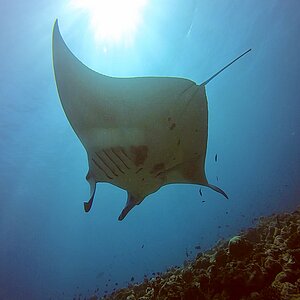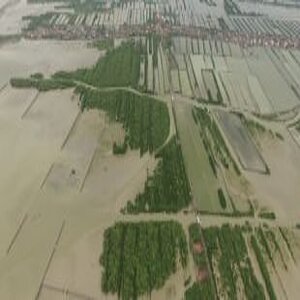Building with Nature: scaling solutions to flood threats across Asia
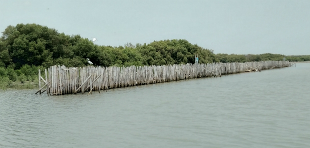
At COP25 in Madrid, this IKI project shows how ecosystem restoration combined with engineering, through a process of ‘building with nature’, is helping Indonesia become a pioneer in coastal resilience.
With the impacts of climate change growing, Asia’s coastal areas are increasingly vulnerable to disasters such as floods, typhoons and tsunamis. At COP25 in Madrid, this IKI project shows how ecosystem restoration combined with engineering, through a process of ‘building with nature’, is helping Indonesia become a pioneer in coastal resilience.
It is a long drive to the village of Timbulsloko on the northern shores of Java, Indonesia’s most populous island. There is water either side of a causeway that stretches for five kilometres through flooded fields, passed crumbling houses reached by rickety walkways, and a village cemetery that is largely washed away.
A lethal combination of rising sea levels, lost coastal mangroves and sinking land caused by groundwater abstraction in the nearby city of Semarang had allowed the Java Sea to invade. Two villages had entirely disappeared. Some 20 square kilometres of the once-prosperous rice-growing district of Demak had been inundated.
Intact coasts ensure survival
Indonesia is an archipelago of islands with thousands of kilometres of low-lying coast, once fringed by mangroves that absorbed the ferocity of storms and prevented erosion by the waves. Until today Java has lost 78 per cent of its mangroves, exposing coastal communities, ports and cities.
But the villagers were fighting back. For several years the people of Timbulsloko and eight other villages have been working with their local and national governments, along with Dutch engineers and environmentalists and the not-for profit-organisation Wetlands International as part of the IKI project "Ecosystem-based adaptation at scale through Building with Nature - Towards resilient coasts in Indonesia", to restore riverine mangroves along aquaculture ponds, and to line the shore with permeable barriers made of brushwood that aim to halt erosion and restored mud banks where mangroves will regrow naturally.
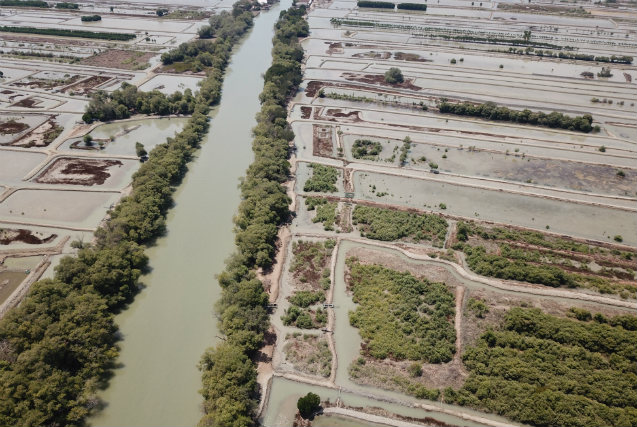
Deltas and coastlines, which are home to hundreds of millions of people in Asia, when starved of sediment and lacking vegetation are wide open to erosion and inundation by rising tides. But if they can be given plentiful supplies of sediment and retain their vegetation, they can both rebuff the waves and even rise up naturally as the seas rise.
Win-win for people and nature
While the villagers are focused on survival and the recovery of their land, their partners believe that the work is an inspiring example of adapting to climate change that will be applicable in the coming decades across Southeast Asia and beyond to future proof cities, coasts and rivers. They call it Building with Nature: a design philosophy that integrates the services that nature provides into civil engineering practice. It allows engineers to work with nature rather than against it, and sees community involvement as central.
After tentative beginnings in Demak, the government has embraced Building with Nature and is scaling up rapidly. Almost 30 kilometres of permeable barriers have been put in place along the Java coast and on the islands of Lombok and Sulawesi, where there is a plan to restore mangroves to protect Palu Bay, after a damaging tsunami in 2018. And the method works. Behind permeable structures extensive sediments have accumulated and mangrove seedlings had started to emerge everywhere.
In Timbulsloko and its neighbours, the communities were not paid for their labour in erecting the permeable barriers. Instead, they received loans for development projects using coastal resources, such as improving the productivity of their fish ponds and providing facilities for tourists. And they were given places at coastal field schools, where they learned how to increase income from their fish ponds, while at the same time protecting coastlines, often by restoring mangroves around the ponds along the coast and rivers.
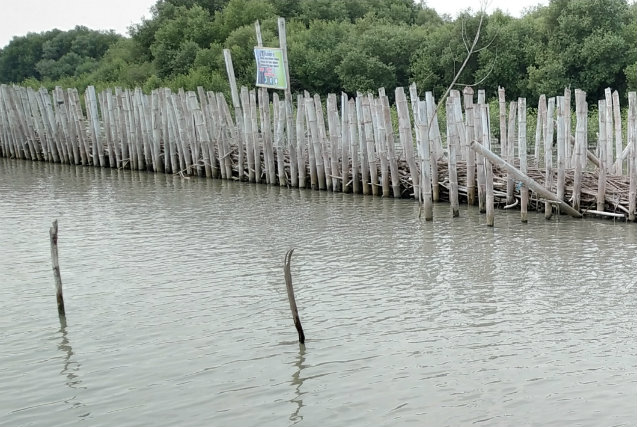
Communities have started to recognize the importance of mangrove conservation and have allocated land along the coast and rivers for mangrove restoration. Independent studies have shown that the 400 hectares of ponds that have adopted best practice are seeing tripled yields and doubled incomes.
And while land subsidence has limited mangrove restoration in villages close to Semarang, the permeable structures have stopped erosion, and that is a big gain for the villagers and promising for other villages along Northern Java’s delta shorelines where in the long run millions of people may be affected by coastal erosion.
Building with nature also helps the cities
While often seen as best suited for protecting rural landscapes, Building with Nature can be vital for urban environments too. Just down the coast from Timbulsloko stands the booming city of Semarang. It is a menace to itself. New industries extract water by pumping from the muddy sediments beneath the city. The result is massive land subsidence, both in the city and along the coast. Some of the organizations involved with mangrove restoration in the villages have been advising on how to use Building with Nature methods to restore the city’s hydrology. Proposals include switching to surface water supplies to allow an end to groundwater pumping, as well as better management of storm water after rains, and the integration of a planned coastal road into a scheme to protect the coastline with a 2000-hectare mangrove and fishing park.
The link has been copied to the clipboard
Contact
IKI Office
Zukunft – Umwelt – Gesellschaft (ZUG) gGmbH
Stresemannstraße 69-71
10963 Berlin



